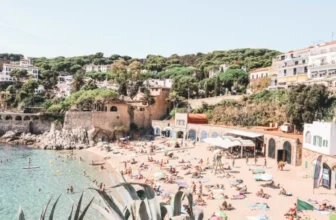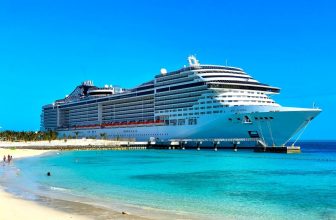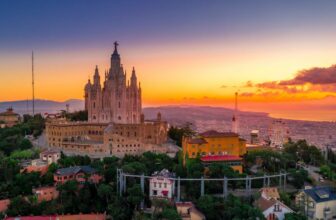Before travelling to Costa Brava this June I had always been a pretty negative view of Spain. In my mind, I always associated Spain, and its many beach resorts, with mass tourism, package holidays and overcrowded cities. While I now realize this was a very unfair and untrue view of the country, we sometimes can’t help have preconceived misconceptions about a destination. I never imagined there would be QUITE so many amazing things to do in Costa Brava, besides lying on a beach or partying!
My week-long trip to Costa Brava, known as “The Brave Coast” changed all that. Within hours of touching down in Girona Airport and making our way to the gorgeous coastal town of Tossa De Mar, my view of Spain had changed. We drove past quiet, untouched beaches, tiny villages oozing with character, ancient forts, and water so blue I half wondered if I had been transported to the Carribean.
Why You Should Visit Costa Brava
View this post on Instagram
Amazing Seafood and Restaurants
Sitting outside a popular seafood restaurant in Tossa, with our waiter dancing to the beat of the afternoon sun, and the sangria flowing easily into our empty glasses, I knew this was a place I would want to come back to again and again. We dined on a feast of Black Rice Seafood Risotto (blackened from the ink of squid freshly caught by local fishermen), entrecote steak, vegetarian paella and a bottomless bowl of olives, enjoying the afternoon sun and the entertainment provided by our lively waiter! Our trip to Costa Brava had only just begun and yes we all had this holiday glow that we hoped would last the entire week.

Our trip consisted of endless trips to either well-known restaurants in the region or little, unknown gems that should most definitely be on the tourist map. From seafood tapas to a restaurant frequented by Dali himself, to small, seaside cafes so close to the beach you can feel the sand beneath your toes while you await your food.
One of the foodie highlights was definitely our farewell dinner at Esblanc Blanes, a restaurant overlooking the ocean in the town of Blanes, the official starting point of the Costa Brava. Nothing beats a restaurant (that turns into a lively bar and club later in the night) where you can watch chefs preparing your food in front of your eyes. From the way every one of our seven courses was prepared and presented to the unique shell-themed crockery and mouth-watering cocktails, this is a restaurant I would travel the whole way to Costa Brava to eat at again.
The unusual food choices we were given, much to some peoples delight and other peoples horror (apologies to any vegetarians!) included sea urchin, prawn sushi, warm pea and avocado salad and a whole lot of oysters!

Snorkeling in crystal clear water
In an effort to walk off those seven courses and bottomless Sangria, we also tried to fit in as many activities as possible. From snorkeling along the coastline, learning about what underwater life we might encounter and discovering hidden coves with a local diving school, to sea kayaking and getting a unique view of Costa Brava’s most impressive sea-view villas, there’s no shortage of adventurous activities in the region. Snorkelling along the coast is by far one of the most exciting things to do in Costa Brava, and probably my favourite!


St Clotilde Gardens
We also loved visiting the Santa Clotilde Gardens with spectacular views of the coastline and hidden beaches, and a beautiful place to walk around or spend an afternoon relaxing. From the unusual mermaid statues, elaborate steps and pathways to the luxurious cliffside villa, this is definitely one of the top places to visit in Costa Brava.

Costa Brava Coastal Path
One thing I was particularly fascinated by and enamored with, was the Costa Brava Coastal Path, a 200km long walking bath linking Blanes to Port Bou. While we only walked a very short and accessible part of the path, I was told that many people walk the entire route in a week or two.
While the path is very beautiful, and the ocean views really will take your breath away, it’s the history of the path that interests me. Our kayaking instructor told me that it was originally built for Spanish officials to patrol the coast for pirates, which is also the reason you will find so many forts and watchtowers dotted along the coast. As time moved on, the path was used by the coast guard to patrol for drug smuggled, but once they opted to patrol from the sea rather than land, the path was left untouched. It eventually became a popular walking path and later a tourist attraction in its own right.


The ancient city of Girona
Girona, the main city in Costa Brava, was also a pleasant surprise. I’ve always put off visiting Barcelona, despite all the wonderful things I’ve heard about it, due to the fact that it’s one of the most visited cities in Europe and always looks uncomfortably crowded! Girona appears to be the polar opposite, with very few tourists and plenty of space to stroll down the gorgeous, cobblestone streets and admire the medieval old town.
We had a lot of fun learning about all the Game of Thrones filming locations around the city and were told much of Season Six was filmed here. Most GoT’s filming locations around the world are pulsating with huge groups of fans on tour, but in Girona, it’s almost like its a well-kept secret! Wondering where to stay in Girona? Check out this gorgeous airbnb apartments.

The Dali Museum
One of the highlights, for me at least, was visiting the much anticipated Salvador Dali Museum in the small town of Figueres. I’m not much a museum person, usually opting to explore the outdoors, do a food or photography tour or pretty much any option that doesn’t have me cooped up inside a museum on a sunny afternoon.
The Dali Museum, however, was probably one of the most unique places I’ve ever visited and my only regret is that we didn’t have longer there. From his unique way of seeing the world to wandering from gallery to gallery admiring his many sculptures, paintings, and even breathtaking jewelry, there’s something special about visiting a museum that the artist himself decided to build. He was involved in the concept, the idea, the design and the building of the museum, which he wanted to house his best work – and no one else’s! This is a museum you must see for yourself to understand who magnificent it truly is.


While most people will come to Costa Brava for the beaches, the cliff walks and the world-class snorkelling, I actually was more drawn to the medieval villages of Catalunya, slightly inland from the coast.
I had just arrived from Emilia Romagna in Italy, a region well known for its food culture, gorgeous architecture and fairytale towns and villages. I was sure no town in Spain could possibly impress me more than Brisighella.
Wrong again.
Towns and villages to visit in Costa Brava
Medieval Villages
Our trip to the medieval town of Besalu, just 40 minutes outside of Girona, yes again shattered my misconceptions about the region. The entire town was declared a Historical National Property by the Government of Spain in 1966 due to its historic importance, particularly in medieval times. The bridge you cross to enter the old town is almost 1,000 years old, and the old town and ancient walls are still in the same place with the same layout as they were in centuries before.
There are lots of beautiful squares to sit in and watch the world go by while enjoying a cafe au lait, some gelato or even some traditional tapas.

One medieval town would never have been enough to quench my desire, and so I was delighted to learn we would be spending our final morning cycling through the medieval village of Palau Sator and Peratallada. If I thought Besalu was the most charming town I had ever laid my eyes on, then it was only because I had never walked the cobbled streets of Peratallada.
With colourful hanging baskets and ivy-covered houses, small alleyways housing hidden bakeries and homemade gelato and an atmosphere that would convince you that you’ve travelled back in time, this is probably one of my favourite medieval towns in the world.

Cycling through the countryside
Our cycling tour concluded had a sweet conclusion, finishing up in Mooma Cideria, the only cider producer in a 500km radius. The Cideria also has a picturesque gift store and restaurant, where we were treated to yet another indulgent feast of our favourite Spanish delicacies with more than a few glasses of freshly pressed apple juice and cider.
A sweet end to our cycle, and the perfect conclusion to a magical 5 days in Costa Brava.
So, had this convinced you to visit Costa Brava? Below are all the details you need on where to stay and how to get there. Any questions? Let me know!
Where to stay in Costa Brava:
We stayed at the 4-star Premier Gran Hotel Reymar & Spa which definitely has one of the best views in Tossa De Mar, with a panorama restaurant with sunset views of the fort and overlooking a small, private beach. The breakfast buffet every morning was spectacular, and there was nothing better than waking up the sea views. Depending on your budget, there are lots of great options up and down the coast but I personally loved our stay here and would highly recommend!
How to get to Cosra Brava:
The closest airport to the Costa Brava is Girona, which is very well connected and has the added bonus of being less than an hours drive to the beach! Jet2 fly from Belfast to Girona, as well as many other cities across England and Scotland. The benefit of booking the complete hotel and flight package through Jet2 is that it makes your holiday less stressful and your flight will include up to 22kg of check in-luggage, a rarity with airlines these days!
Editors Note: Special thanks to Jet2 and the Costa Brava Tourism Board for organizing this incredible trip to Costa Brava. As always, all opinions are my own!
Last updated on October 13th, 2023 at 01:05 pm























